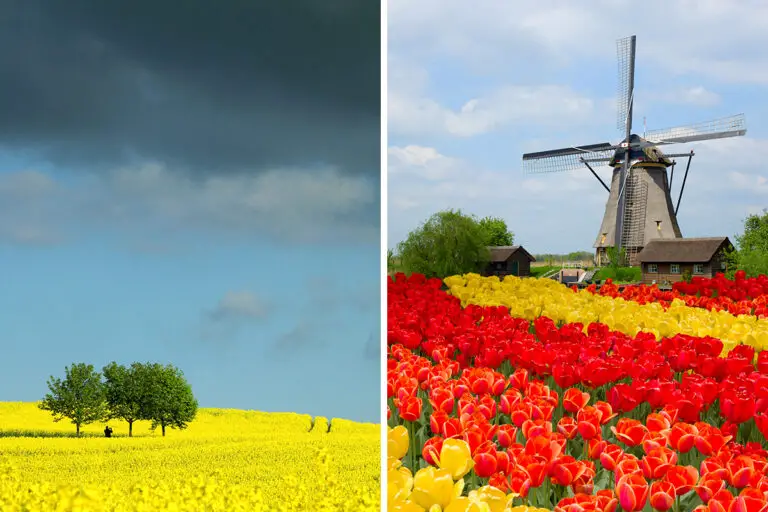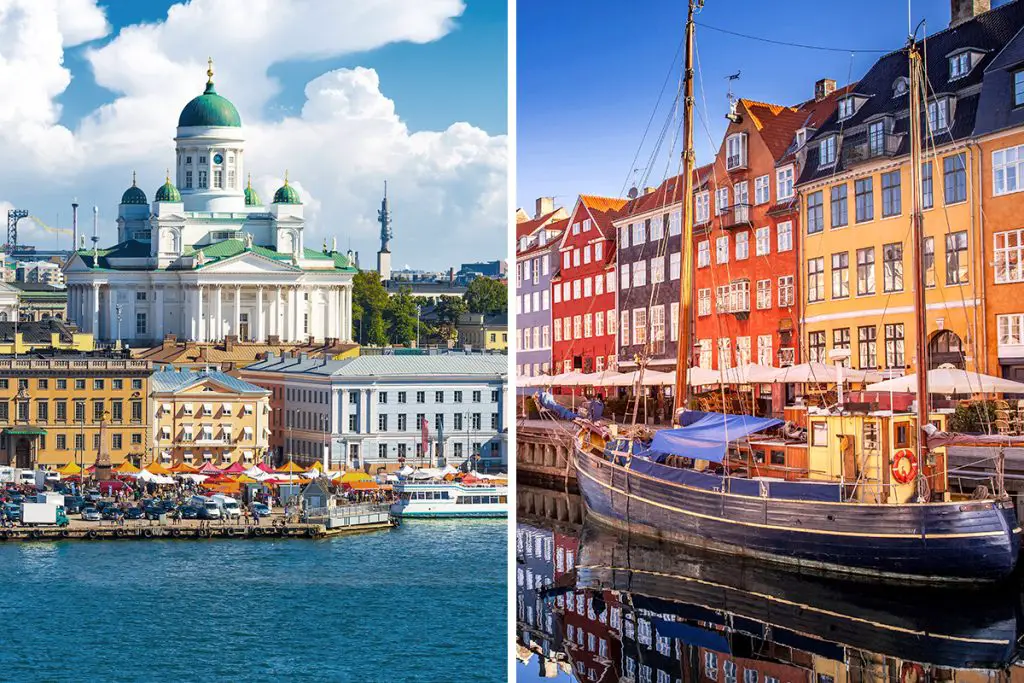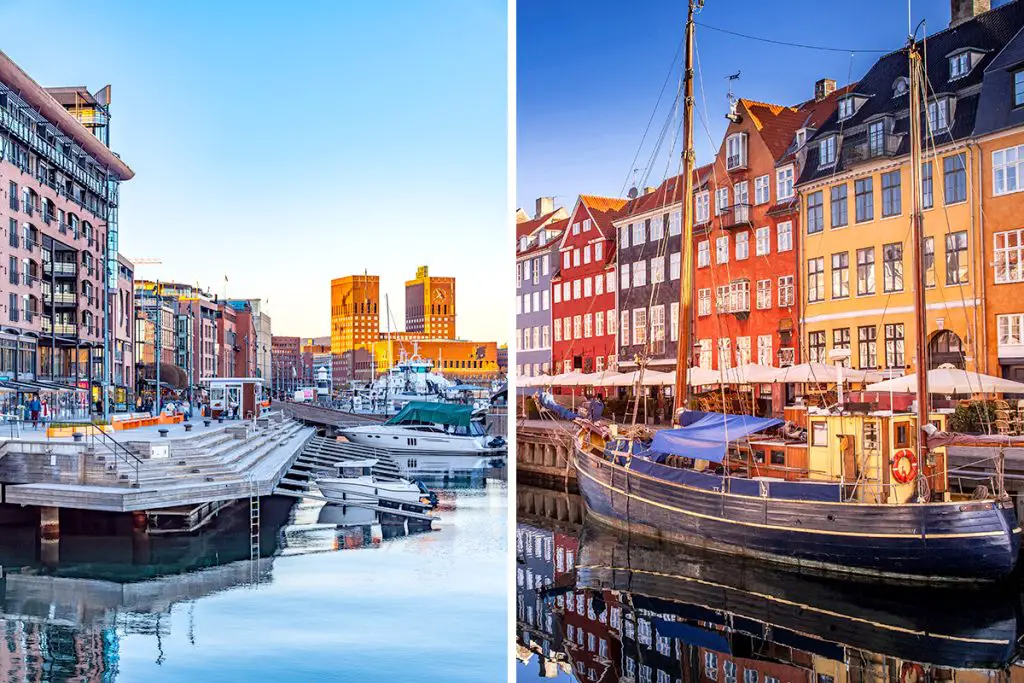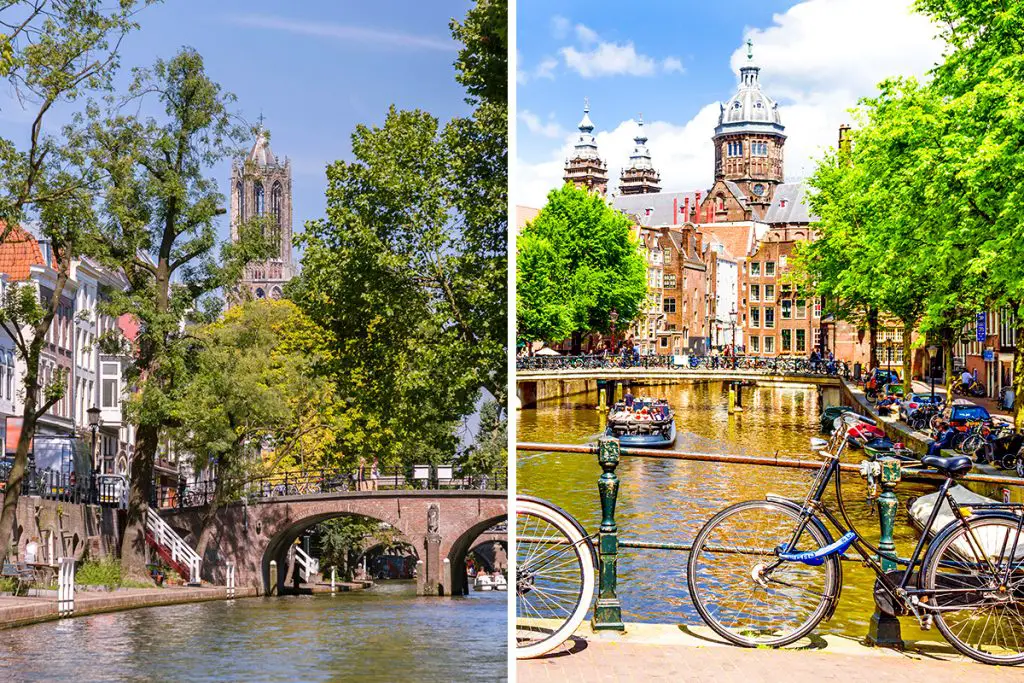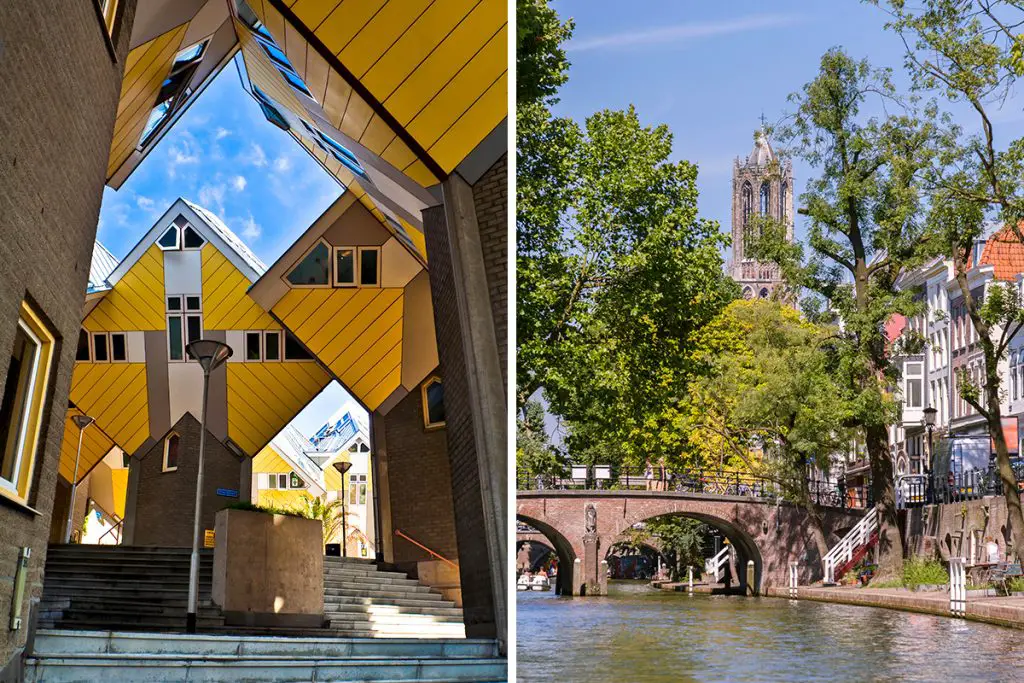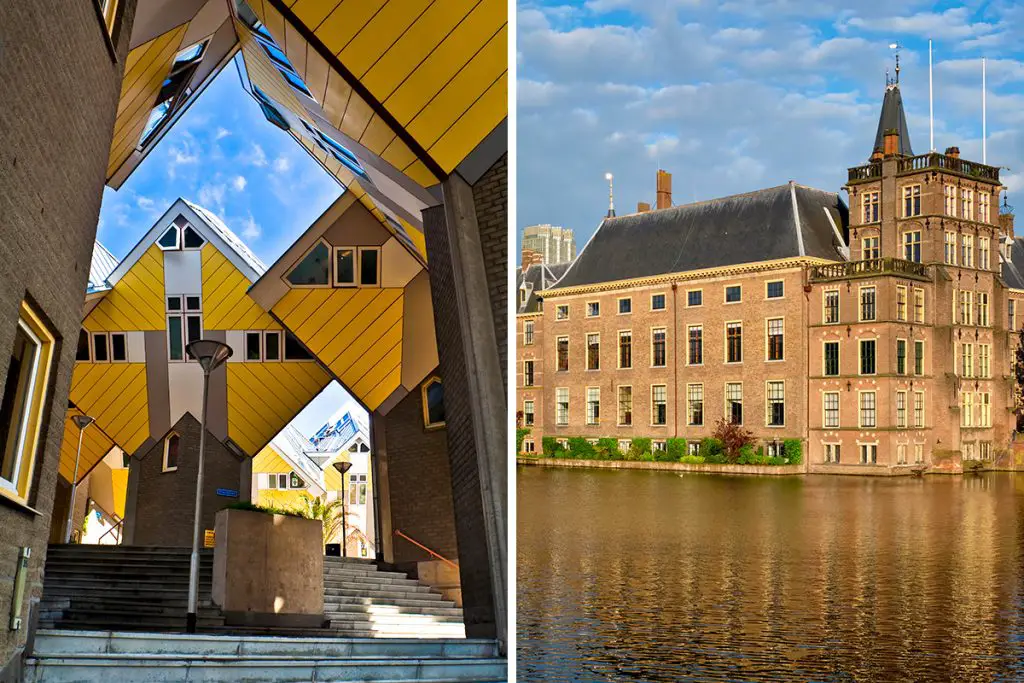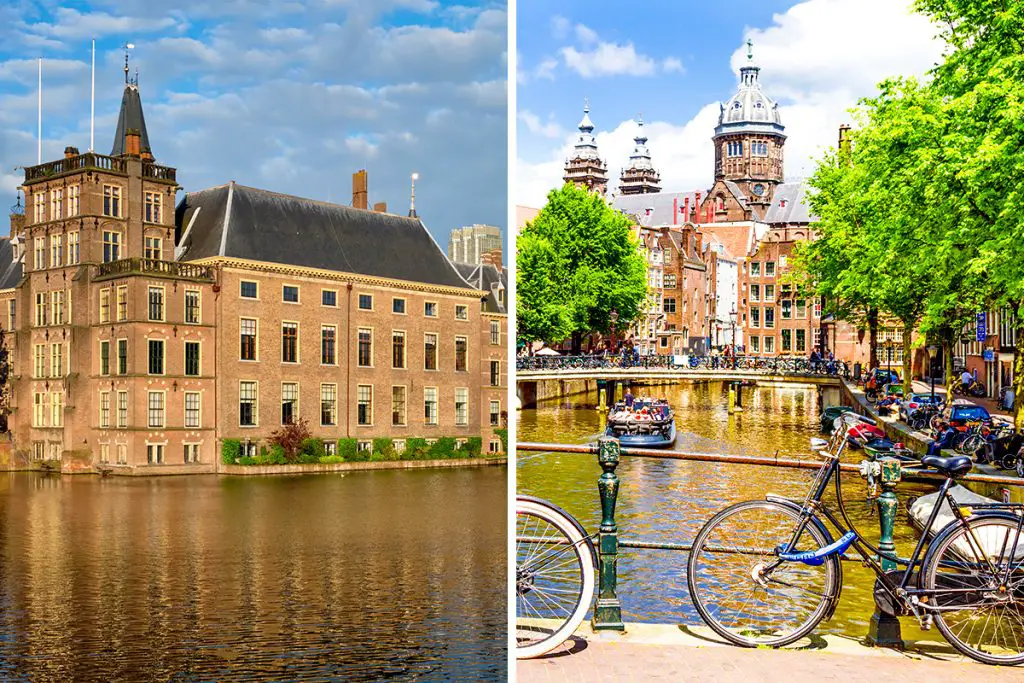If you’ve lived in Denmark and visit the Netherlands, you’ll instantly notice how crowded it is.
Population densities are just one of the many differences between Denmark and the Netherlands. For some, this can be a dealbreaker, especially if you’re after a more relaxing vacation.
In Denmark, specifically Copenhagen, you’ll find a lot more locals. Whereas in Amsterdam, Netherlands, it’s more packed with tourists. This should give you a good idea of what to expect if you visit either country. That said, this is only the beginning.
If you’re more into sightseeing like mountains and islands, Denmark will give you your money’s worth. But if you enjoy activities like bicycling through endless fields of flowers, the Netherlands has tons of them.
In fact, the Netherlands is a rather flat piece of land, geographically speaking. Compared to Denmark, which has a diversified landscape.
Now that you have a basic idea about each destination, keep your thoughts on hold first. Before you decide, here’s a complete rundown of what Denmark and the Netherlands have to offer vacationers.
Denmark
It’s hard to find reasons why you shouldn’t visit Denmark. The country’s widespread Hygge culture alone is a heartwarming trait of the Danes anyone would be naturally drawn to.
Beyond the country’s much-prized Hygge culture, Denmark is a beautiful country. And even beautiful is an understatement. Imagine canals, colorful architecture, Renaissance castles, and virgin landscapes all in one place. These create a Danish appeal easily pleasing to the eyes.
There’s so much to see in this country. But above all, Denmark is a place where you can truly feel what it’s like to step back from the daily city grind. Here, you can soak in panoramic landscape views and immerse in quieter pleasures.
Even better, the country prides itself on its bike culture. That’s sustainable living for you, alright. So much so that the number of bikes outnumbers the number of cars.
There are plenty of reasons to love Denmark. And it without a doubt deserves a high-ranking spot in bucket-list-worthy vacations to visit. Consistently ranked as one of the happiest countries in the world, visiting once might even convince you to stay.
For all the reasons to love Denmark and why you should visit, head to the next sections below.
What Makes Denmark Unique?
Denmark Is One of the Safest Countries in the World
And it’s also home to the safest city in the world, according to the Economist Safe Cities Index. Denmark’s capital, Copenhagen, tops the charts when it comes to safety and it’s no surprise. And it’s backed by very low crime rates, along with a high level of trust among the locals.
For solo travelers and families traveling with kids, safety often comes up as a high concern. Well, in Denmark, that’s hardly an issue. This may also have to do with the fact that Danish culture is deeply rooted in Hygge (more on this later).
You may have also heard how high Denmark ranks on the happiness scale. Not only are the locals super-friendly, but that extra bag of happiness that’s clearly noticeable goes a long way for any tourist.
In fact, did you know that Denmark is constantly cited as one of the most livable places globally? This also ties back to how safe and at ease tourists will feel when visiting Denmark. Not once or twice, but several times over.
The Hygge Quality of Life
The Oxford English Dictionary defines Hygge as…
“a quality of coziness and comfortable conviviality that engenders a feeling of contentment”
But that’s a complicated way of saying it.
Hygge, defined as the Danish way, is taking the time to slow down. It’s appreciating the little things. And most of all, breaking out of the daily rush to spend time with those you care about most or yourself.
In other words, Danes embodying Hygge have small demands and are happy with what they receive.
This embodiment is what makes Denmark such a safe place to live in. Not to mention, it’s no wonder then why it’s ranked as one of the happiest countries in the world. Above all, this chart-topping contentment as a result makes it an appealing place to live in.
For a first-time visitor, being able to witness this can be shocking. And spending time with the locals can only mean a good thing. Especially if the Hygge positivity rubs off on you.
So, is Denmark worth visiting? More than you could ever know. In a world where happiness is valued higher than a country’s GDP, you can only expect great things.
If being born in Denmark means having the winning ticket to a happy life, wouldn’t you be curious? To learn about the secrets of a happy life? Of a higher quality of life? Or having a work-life balance for the rest of your life?
Overall, the happiness and Hygge culture of Danes ties back to all of Denmark’s amazing qualities. And it’s become a role model for countries all over the world.
Just think. Where do low corruption, a low crime rate, and personal tourist safety come from? If the locals are deeply rooted in positive beliefs, that in turn contributes to society’s overall aura. Which as a result, is largely beneficial for tourists. Be it solo travelers, couples, families, and so on.
Cleanliness, Green Outdoor Spaces, and a Ton of Opportunities to Unwind
Cleanliness might not be the first thing you think about on a vacation. However, it makes a huge difference. Especially when you’re traveling with kids.
And what’s the biggest benefit of a clean country? Fresh, breathable air. Speaking of which, Denmark is home to dozens of outdoor spaces to give you the best of both worlds.
The scenery you’ll find here is absolutely breathtaking. From coastal cliffs to parks and islands. For the locals, soaking up views of peaceful scenery has become part of their daily habits. And why shouldn’t it, right? With all this nature and natural beauty around you, it’s a waste to leave them unappreciated.
On that note, Denmark’s landscape is so rich and diversified you aren’t limited to just seafront views.
One of the most popular places to unwind and recharge in Denmark? The white cliffs of Møn. Beautiful, chalky white cliffs that overlook the sea are truly one of a kind. However, getting to the top of these cliffs asks for a small effort.
From the beach to the clifftop, you’ll have to climb a moderate number of steps that can prove to be quite the exercise.
Rabjerg Mile, also known as the Danish desert, is one of Europe’s largest migrating dunes. From here, make your way to Jægersborg Deer Park, one of the most visited natural sites in Denmark. Plus, you’ll have the opportunity to get up and close with over 2,000 deer.
Up for a hiking exploration? Don’t miss Rold Forest. Ancient pine trees, beech trees, and tales of trolls have made Rold Forest one of Denmark’s best attractions.
However, nothing compares to the natural wonder found in Grenen. Imagine two seas coming together and colliding into a wave spectacle unlike anything you’ve ever seen. This collision is so strong that you’re forbidden from swimming here. That said, you’re welcome to dip your toes in Grenen’s shallow waters.
Denmark is home to some of the world’s most beautiful landscapes. And for any vacationer, these natural wonders are just one of the many reasons why Denmark is worth a visit.
Full of Life’s Quiet Pleasures
Denmark continually captures global attention for its many qualities. Sustainability, work-life balance, culture, architecture, and even urban planning. When it comes to life’s quieter pleasures, Denmark also punches above its weight.
For starters, the country features a long list of art galleries and museums. Each with its own impressive art collection. The National Gallery of Denmark is one such example. And one that will definitely captivate your interest is the ARoS Aarhus Art Museum.
Architecture lovers and history buffs will also love Denmark’s many Renaissance castles and palaces. Kronborg Castle is popular for several reasons, and not just for those with a love for history. Also known as Hamlet’s castle, it served as Shakespeare’s source of inspiration for the ever-popular drama.
For modern architectural inspiration, check out the Royal Library in Copenhagen and Royal Danish Opera.
Denmark’s list of quieter pleasures doesn’t stop at art galleries, museums, and castles. You’re more than welcome to unwind and slow down at any of these places.
But for a mix of inspiration and peaceful exploration, visit Tivoli Park.
Every year, the park receives over 4 million guests. But even more interesting to note are the people that have visited. Hans Christian Andersen, famous fairy tale writer, has visited Tivoli Park several times.
In fact, Walt Disney found his inspiration to build Disneyland upon visiting the park.
Who knows, you might just find creative inspiration when you’re here too. But most of all, Tivoli Park is definitely one of the best places to take a break from the daily hustle and grind.
Netherlands
On the surface, the Netherlands seems like a flat country, so there must be nothing worth seeing, right? Wrong. This country is full of color and charm. Tons of it, in fact.
Could you imagine an endless field of tulips? What about cherry blossoms? Orchids and lilies? Or peonies? Well, put all those together in one massive field and you have an endless garden bursting with colors.
Now, colorful fields are only a fraction of the beauty you’ll witness in the Netherlands.
You’ve heard about the Netherlands’ canals, right? Waterways that once served as the main transport artery in the Middle Ages never cease to amaze. What’s more, the Gothic architecture and gingerbread houses along these canals are a marvel to behold.
Take a photo op, immerse in the beauty, or gallivant in a water taxi. Any one of these activities will make you realize just how beautiful the Netherlands is.
But that’s not all.
With canals already being impressive enough, the country is also home to centuries-old windmills. What significance do windmills have in the Netherlands? Throughout history, these windmills were used to drain swampy marshlands around the country.
With hundreds still scattered throughout the pancake-flat country, many have become national monuments.
Even something equally impressive as the windmills you’ll find here are the thousands of cafés. No, not that kind of café – nothing of the coffee sort.
In the Netherlands, the Dutch refer to a café as a pub. You’ll find a café on just about every corner, block, and alley of the Netherlands. From cafés on the main town square or hidden spots to cafés beside flowery terraces or right along the canals.
After all, the Dutch value an intellectual or interesting conversation more than drinking. Apart from all those already mentioned, the Netherlands has even more to entice tourists with. You’d be shocked to find out what those are in the next sections below.
What Makes the Netherlands Unique?
The Landscape of the Netherlands is Full of Colors
Time and time again you’ve heard that most of the Netherlands is below sea level. And given its pancake-flat geographical landscape, who would think that the country’s landscape is diverse?
Not many.
Compared to Denmark, it might not be as diverse, but that doesn’t mean it isn’t beautiful. Or that it doesn’t have a mild diversity of its own.
Search up the Netherlands on Google, and 9/10 times you’re bound to see images full of color. Or rather, full of vitality and life. This is what makes the Netherlands’ landscape so appealing to many.
Their innovative agricultural techniques and passion for floriculture make it a colorful spectacle. No matter the angle.
It would be an understatement to say these colorful farmlands are Instagram-worthy. Or solely meant for one or two camera snaps.
It’s safe to say you could name more than 10 flower species in a single photo. That alone isn’t just a beauty worth appreciating. It’s the Dutch’s love for their agriculture. A skill that hundreds of countries have also benefitted from.
Now if you’re thinking that you’ll only find tulips here, think again. While it’s true that tulips are the emblems of the Netherlands, it’s not the only species you’ll find. There are daffodils, orchids, carnations, hyacinths, gladiolas, lilies, and so much more.
Did you know? The Netherlands produces the widest variety of shrubs and saleable trees in the world. But variety is only half of what makes the country’s horticulture efforts impressive. The Netherlands also produces hundreds of new varieties every year.
There’s an endless array of color combinations here, giving birth to an actual paradise of its own. While in the Netherlands, don’t miss the famous floating flower market in Amsterdam.
And of course, who could forget? The Keukenhof flower park is the largest flower park in the world. Every year, there are more than 7 million flowers planted at Keukenhof. Worth the visit? Every single minute.
A Sanctuary for Biking
Biking in the Netherlands isn’t just an activity the same way you treat swimming as an exercise. Rather, biking in this colorful country is a luxury. And it’s a 19,884-mile (32,000 km) stretch of luxury that even the locals don’t get tired of doing.
Because cycling is so popular in the Netherlands, it’s also become the most favored mode of transport. For tourists that want to experience the country like a local, rent a bike and pedal away.
In fact, most of the Netherlands is easily accessible via bike. Sure, you might have to pedal a lot more than you’re used to. But at the same time, you’re granted scenic views, colorful majestic fields, and a bike ride unlike anywhere.
One of the best biking trails in the Netherlands? Hoge Veluwe National Park. Ask any local about biking trail suggestions and there’s a very high chance Hoge Veluwe will come up.
But if you prefer a more detailed itinerary, here’s a good one for you—
From central Amsterdam, head to Waterland loop. This is a classic scenic route for many cyclists. And its expansive green spaces filled with canals, dikes, and cows are part of that scenic beauty.
After Waterland loop, make your way to Sterresbosweg until you reach Boscche Boek. Here, you’ll find an even more massive meadowland – about 202 hectares (499 acres).
Then, don’t miss the biking trail from Leiden to Bulbfields Loop. From mid-March to May, this is when the daffodils and tulips along this route are in full bloom. And when all the color catches your eye, you’ll definitely want to stop and soak up the grand view.
With so many biking trails all over the Netherlands, it’s impossible to mention them all. However, a few extra routes should come in handy. Some of these include Woudenberg, Posbank, Ooijpolder, Scheveningen, and Texel.
If you have extra time to spare, be sure to also check out Vondelpark and the Frisian Islands. These are definitely places you’d want to bike and explore more than once.
Thousands of Cafés (Pubs)
The Dutch do love their beer. So much so that there are more than 600 types to date. Currently, there are over 900 breweries in the Netherlands. It’s also worth noting that 204 breweries out of the 900 are found in one province: Noord-Brabant.
With more than 900 breweries to date, how many cafés or pubs do you think there are? As of 2022, there are more than 12,000. In the country’s capital, Amsterdam, there are 1,200 pubs.
What’s even more interesting is that some of the breweries even date as far back as Roman times. These breweries or monasteries have been brewing beer with recipes that have constantly evolved since the Roman era.
So, how much do you think the taste and flavor have evolved throughout the years? You’d probably find a good number of holy grail beers here then.
Speaking of which, beer connoisseurs may just find it hard to put their mug down after they’ve had a sip. As for casual beer drinkers and those that aren’t particularly fond of beer? It’s highly recommended to try one. You’ll quickly realize why the locals love beer. Or, it might just convert you.
Now, before you’re quick to think that the café’s in the Netherlands as loud and rowdy, that’s not quite true. Of course, you’ll find plenty of that, considering you have 1000+ options.
But for the most part, cafés in the Netherlands are also where the locals go to break conversations, be it intellectual, a catch-up with friends, or contemplation.
These are places for camaraderie, and even tourists will feel welcome at these cafés, too, because after all, the Dutch are well-known for their conviviality.
So, grab a Netherlands beer (try as many varieties as you can) and enjoy local homebrewed goodness alongside a local.
Places to Slow Down and Theme Parks for Anyone After a Thrill
If not windmills or tulips, the Netherlands is also famous for its many enriching historical sites. Some of these include the Anne Frank Museum, Rijksmuseum, and Kasteel De Haar. Even the iconic Erasmusbrug Bridge is a world-famous attraction, along with the Village of Kinderdijk.
But while all these attractions are perfect for those that want to slow down, well…
Who would’ve guessed that the Netherlands is full of theme parks for adrenaline junkies too? And currently, there are 15 throughout the country.
For any adrenaline addict, visit De Efteling – the most popular, beloved, and largest in the country. This fantasy theme park has been around since 1952 and is comparable to Universal Studios and Disneyland.
Although widely popular among adults, there are dozens of rides in De Efteling for kids too! For roller coaster lovers, Walibi Holland is your next best pick. The park boasts the highest concentration of roller coasters in the country.
Don’t worry, though. Walibi has more than enough rides for kids too.
Moving past thrill-seeking rides and roller coasters sits another theme park, The Amsterdam Dungeon. But unlike the other two mentioned, the park prides itself on one theme: horror. In addition, there are a total of 11 live scary shows at The Amsterdam Dungeon.
If that’s not enough to send a chill down your spine, you can do the walking tour. Inside the dungeon, there are torture rooms and a dark past that will surely put your love for horror to the test.
Lastly, don’t miss Duinrell. Although smaller in comparison to most theme parks, it’s famous for its water park. However, it’s not just any ordinary water park. Some of the largest slides are found in Duinrell. Not to mention, heaps of options to swim in, including mammoth waterfalls and water rapids for the family to enjoy.
Which Is Better – Denmark or Netherlands?
So, which is better?
It depends mostly on the kind of vacation you’re after.
Denmark offers gravitating qualities that have made it one of the most livable countries in the world. From its landscape choices for exploration to its wealth of options for experiencing life’s quieter pleasures. Plus, Denmark is one of the safest countries worldwide. Not to mention, home to the safest city in the entire world.
Even the Danish way of living, culture, and the locals’ infectious vibes of positivity are enough reasons to visit. Denmark suits travelers where natural beauty and majestic landscapes are easily accessible.
The country is peaceful and full of locals that can teach you a thing or two about happiness. In fact, the Hygge way of living is so inspiring that it might just root new beliefs in you on how to live life. Where else do you find that on a vacation, right?
If Denmark is more outdoorsy and has natural beauty all around, the Netherlands is more city life. In fact, the nightlife in the Netherlands is better too. You also have a lot of landscapes to explore, along with theme parks, museums, and villages for those that want a slower pace.
One of the biggest highlights of visiting the Netherlands? You can do long-distance bicycling on flat land and ride for days to a seemingly endless horizon. Not only that, but the views are breathtaking. And the color of life in the country’s flower fields and open spaces are absolutely magnetizing.
What the Netherlands lacks in the diversity of its landscapes, it makes up for in its amazing bike trails.
FAQ
Is Denmark the Same as the Netherlands?
Denmark and Netherlands are vastly different from each other. Although both are located in Europe, the geographical landscapes alone prove this point.
Denmark has a broader range of landscapes. From mountains and hilltops to coastal cliffs and various islands. Whereas the Netherlands is easily characterized as flat. In fact, more than a quarter of the Netherlands is below sea level.
However, this isn’t to say the country’s landscape is boring and dull.
The Netherlands is full of colorful fields and forests you could easily get lost in awe. Another major difference that sets Denmark apart from the Netherlands? Currency and language.
Denmark’s currency is Danish Krone while the Netherlands’ currency is Euro. As for language, Denmark’s national language is Danish while in the Netherlands, it’s Dutch.
Looking for more proof? Even the weather in Denmark is different from the weather in the Netherlands. Snow is common in Denmark, along with a few winter storms. Whereas in the Netherlands, snow isn’t that common and is typically wet all year round.
Overall, there are a ton of differences between the two. Even the culture. And these points alone prove that Denmark isn’t the same as the Netherlands.
Is Denmark in the Netherlands?
Denmark is not in the Netherlands. Although, it’s easy to mistake that Denmark may be in the Netherlands since both are located in Europe.
That said, just because both are located in Europe doesn’t mean Denmark is in the Netherlands. And that’s because Denmark is located in Northern Europe, specifically between the Baltic and North Seas. Whereas the Netherlands is located in Western Europe between Belgium and Germany.
Denmark to Netherlands Distance
The distance from Denmark to the Netherlands is about 332 miles or 535 kilometers. However, note that this refers to the air distance or if you decide to travel via plane.
With regards to the road distance, the Netherlands is 573 miles (922.2 km) from Denmark.
Is Denmark Bigger Than the Netherlands?
Denmark is slightly bigger than the Netherlands, having a total land area of 16,576.5 sq miles (42,933 sq km). The Netherlands covers a total land area of 16,039.8 sq miles (41,543 sq km).
However, if you include Greenland which is owned by Denmark, the Netherlands is far smaller. With Greenland, Denmark measures a total area of 857,505.9 sq miles (2,220,930 sq km).
In fact, size is perhaps one of the first differences you’ll notice between the two. Despite the Netherlands being smaller, it has x3 the population than Denmark, specifically 17.2 million people. Whereas in Denmark, the total population density is just 5.8 million.
What that means is you can easily tell that the Netherlands can feel crowded compared to Denmark.
Denmark–Netherlands Relations
Denmark–Netherlands relations simply refer to both countries’ cultural, economic, and political relations. This is also commonly known as bilateral relations.
For instance, the Netherlands has an embassy in Denmark’s capital, Copenhagen. Whereas Denmark also has an embassy in Hague. This is to imply that both Denmark and Netherlands are allies that support one another.
What this also signifies is the relationship the Danish (Denmark) have with the Dutch (Netherlands). In fact, Denmark and Netherlands have maintained a friendly and commercial relationship for 500+ years. This goes all the way back to agricultural cooperation between the two countries.
Netherlands to Denmark Flight
A direct flight from the Netherlands to Denmark takes about 1 hour and 30 minutes. This is also assuming you’re flying from the Netherlands to Denmark’s capital, Copenhagen. Direct flights from the Netherlands are easy to find as well. Although in some cases, there are some that have three- or four-hour layovers.
Multiple airlines also offer direct flights from one destination to the other. Some of these include British Airways, airBaltic, Scandinavian Airlines, Vueling, and more.
Denmark to Netherlands by Ferry
There are no boats or ferries with routes that operate from Denmark to the Netherlands. Your best option if you want to travel via ferry/boat is a cruise. It’s possible there may be a 5- to 7-day cruise that stops at both Netherlands and Denmark.
That said, traveling by plane is by far the most common and feasible choice.
Netherlands to Denmark by Car
Traveling from the Netherlands to Denmark by car is also a good option. That is of course if you don’t have a problem with an 8-hour road trip. Although flying by plane is a popular choice, there are a few reasons why some prefer to do a road trip.
For one, there are several stops you can make along the way. These are all great spots for sightseeing and exploring, and a few even for staying the night. Common stops along the Netherland–Denmark route include Hamburg, Dortmund, Utrecht, Bremen, and Essen.
According to Google Maps, the total distance by road is 514.5 miles (828 km). Along this route, it’s also worth mentioning that it’s inevitable you’ll have to pay a one-way toll on the Storebælt bridge.
The toll fee for crossing this bridge is 34 EUR or Euro (USD 35.8 at 1.05 Euro a dollar). If you prefer a scenic, more adventurous vacation, driving from the Netherlands to Denmark is a fantastic option.

